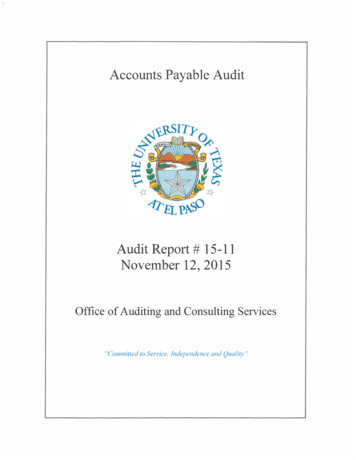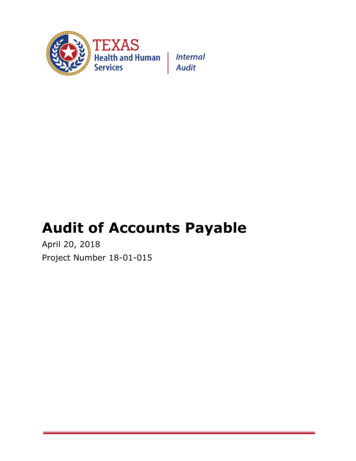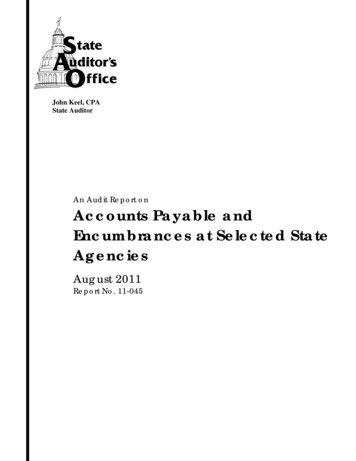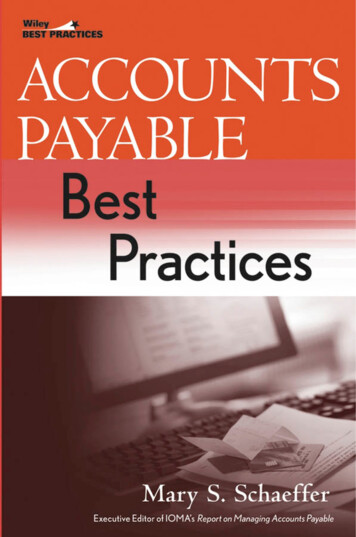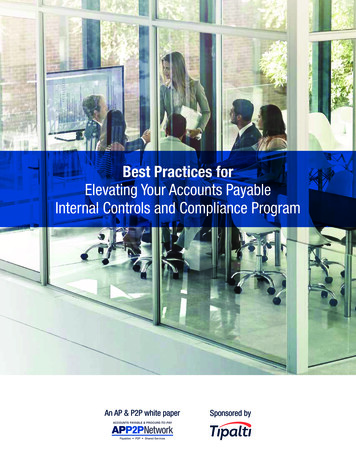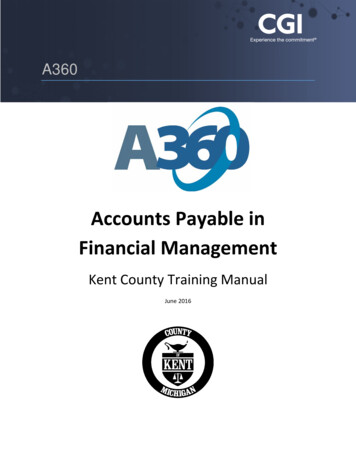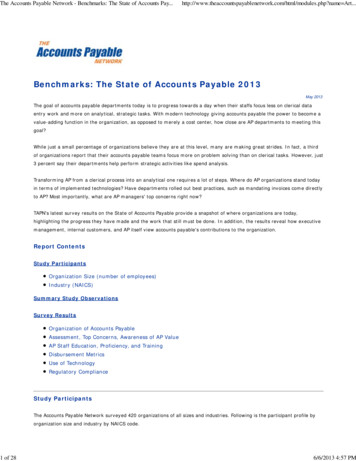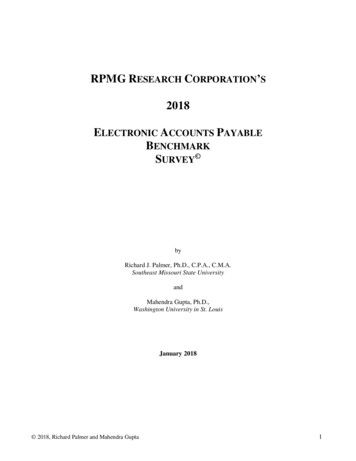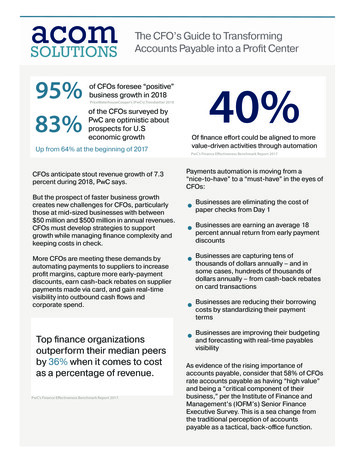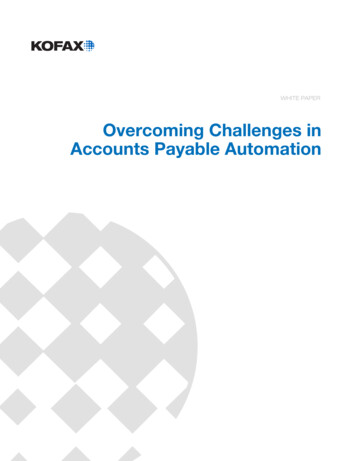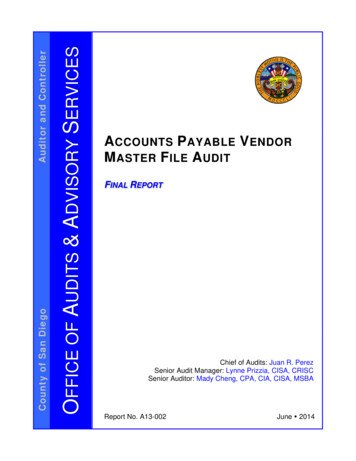
Transcription
OFFICE OF AUDITS & ADVISORY SERVICESAuditor and ControllerCounty of San DiegoA CCOUNTS P AYABLE V ENDORM ASTER F ILE A UDITFINAL REPORTChief of Audits: Juan R. PerezSenior Audit Manager: Lynne Prizzia, CISA, CRISCSenior Auditor: Mady Cheng, CPA, CIA, CISA, MSBAReport No. A13-002June 2014
Intentionally Left Blank
Office of Audits & Advisory ServicesReport No. A13-002INTRODUCTIONAudit ObjectiveThe Office of Audits & Advisory Services (OAAS) completed an audit ofthe Accounts Payable Vendor Master File. The objective of the auditwas to verify that adequate controls exist and are operating effectivelyover the setup and maintenance of vendors in the Accounts PayableVendor Master File.BackgroundThe Auditor and Controller’s Accounts Payable Division (A/P) isresponsible for creating and maintaining vendors for the County. OneA/P staff is primarily responsible for creating new vendor accounts inthe Oracle ERP system (“Oracle”) and three A/P staff are designated asbackups.Prior to 2003, vendor accounts were maintained in the previous ARMSaccounting system. The County implemented the Oracle EnterpriseResource Planning (ERP) system in 2003 and subsequently upgradedto Oracle Release 12 E-Business Suite (R12) in November 2011.According to A/P management, ARMS allowed only one vendor site pervendor account. Therefore, a vendor with multiple sites (e.g., one sitefor store location and another site for accounting department) was setup as multiple vendor accounts. However, a vendor account in Oraclecan have multiple vendor sites and each site can have a differentaddress. During the data conversion from ARMS to Oracle in 2003, themultiple vendor accounts for different sites for the same vendor (i.e.,with same vendor name and same tax ID) were carried over to Oracleas separate vendor accounts.As of October 2012, there were 356K active vendor accounts and 367Kactive vendor sites. There are four main types of vendors in the VendorMaster File: Suppliers: External businesses or individuals that have providedgoods and services to the County. Tax ID is a required data field forthis type of vendor accounts. Employees: Prior to the Oracle R12 Upgrade, all County employeeswere automatically set up as vendors in Oracle for the purpose ofreimbursing job-related expenses. Interfacing Claims: Certain payments are processed via interfacesfrom other systems to Oracle for one-time vendors, such as propertytax refunds. Oracle automatically creates these vendors whenpayment data is interfaced to Oracle. Controls over vendor setup forthese vendors reside primarily at the departments that initiate theinterfaces. A/P does not require certain typical vendor setupsupporting documents for these vendors. Other Vendors: These vendors are created to issue refunds due toexternal businesses or individuals for overpayments not processed1
Office of Audits & Advisory ServicesReport No. A13-002through interfacing claims. Tax ID is not required for this type ofvendor accounts.Audit Scope &LimitationsThe audit covered the Vendor Master File as of October 2012. Thisaudit was conducted in conformance with the International Standardsfor the Professional Practice of Internal Auditing prescribed by theInstitute of Internal Auditors as required by California GovernmentCode, Section 1236.MethodologyOAAS performed the audit using the following methods: Interviewed A/P management and staff to understand the vendormaintenance process and related controls. Evaluated A/P's vendor maintenance policies and procedures foradequacy and appropriateness, and reviewed supportingdocuments to verify existence. Walked through the vendor setup process with the A/P staffresponsible for vendor maintenance to verify that controls were inplace over the setup and maintenance of vendor data stored inOracle. Performed detailed analysis of vendor data downloaded from Oracleand County employee data downloaded from the PeopleSoft HumanResources Management System, including the following: –Identified instances where different vendor accounts had thesame tax ID, bank account number, vendor name, or address inorder to detect potential duplicate vendors.–Matched vendors to employees by tax ID, bank account number,name, and address in order to detect any potential conflicts ofinterest.–Summarized the vendor records created or last updated inOracle in 2010, 2011, and 2012. Identified and researchedinstances where a vendor was not created or updated bydesignated A/P staff to detect unauthorized creation/updates ofvendor records.Verified whether privileged Oracle access related to vendormaintenance was restricted to designated A/P roles, as follows:–Identified all Oracle roles related to Purchase-To-Pay (PTP).–Logged into the Oracle Test Instance using each PTP role.Verified whether the role could perform vendor maintenancefunctions, including adding/updating a vendor, adding a newvendor site, updating the vendor address, and reactivating aninactive vendor.2
Office of Audits & Advisory ServicesReport No. A13-002 Evaluated Oracle roles assigned to all A/P staff to detect anysegregation of duties violation. Tested a judgmental sample of three inactive vendor accounts bylogging into the Oracle Test Instance and verifying that thesesample vendors were not listed in the Supplier data field and thuscould not be used to create a new invoice in Oracle. Tested a judgmental sample of 20 vendor accounts and traced toother sources (i.e., Secretary of State website, County employeedirectory, or W-9 Forms) to verify vendor name and address in orderto detect any fictitious vendors.AUDIT RESULTSSummaryWithin the scope of the audit, controls over the setup and maintenanceof vendors in the A/P Vendor Master File appear adequate, except forthe following:Finding I:Controls to Detect Duplicate Vendor Accounts Could beStrengthenedControls to prevent and detect duplicate vendors in the Vendor MasterFile need improvement, as evidenced by the following:Potential Duplicate Vendor Accounts. OAAS performed detailed dataanalysis of vendor data in Oracle using ACL data analysis andMicrosoft Excel applications to identify instances where different vendoraccounts had the same tax ID, bank account number, vendor name, oraddress. As a result, OAAS identified the following potential duplicatevendor accounts: Tax ID: Of the 356K active vendor accounts, 10K accounts had avalid tax ID (i.e., not blank or zero). Tax IDs of 1,014 of the 10K(10%) accounts were the same for at least two different accounts.For some vendors, different departments of the same vendor wereset up as different vendor accounts, which explained certaininstances of the same tax ID. In addition, according to A/PManagement, when a vendor changed name, the Oracle ERPSystem required a new vendor account to be set up so that thetransaction history under the old name could be maintainedseparately from the history under the new name. As a result, boththe old and the new vendor accounts would stay in Oracle, resultingin multiple accounts with the same tax ID. Name: Of the 356K active vendor accounts, vendor names of 659accounts (0.2%) were the same for at least two different accounts.According to A/P Management, the previous accounting system(ARMS) allowed only one vendor site per vendor account.3
Office of Audits & Advisory ServicesReport No. A13-002Therefore, a vendor with multiple sites was set up in ARMS asmultiple vendor accounts with the same vendor name and tax ID.During the data conversion from ARMS to Oracle in 2003, thesemultiple vendor accounts were carried over to Oracle as separatevendor accounts, resulting in multiple vendor accounts with thesame vendor name and tax ID. Address: Of the 367K active vendor sites, vendor addresses for6,188 sites (1.7%) were the same for at least two different sites.Inaccurate Vendor Records. OAAS performed detailed data analysisof vendor data in Oracle and identified the following incidents: Two vendors’ bank accounts were set up twice in Oracle. Three vendors had the same tax ID in Oracle. Department staffinadvertently entered the same tax ID for all three new vendors onthe supplier request form and submitted the form to A/P. Thedepartment subsequently discovered the error and notified A/P viaemail to correct the error; however, the department did not submitan updated supplier request form and thus the error was notcorrected by A/P.Limited Coverage of Exception Report. The 1099 SupplierExceptions Report, run by A/P every quarter to identify duplicate vendoraccounts, was limited to 1099-reportable vendors (i.e., those subject to1099 tax reporting) with payments in the same quarter. Duplicateaccounts set up for the same vendor in different quarters would notappear in this report. Also, the report did not include vendors who werenot subject to 1099 tax reporting.According to the current A/P policy dated May 2005, A/P staff shouldverify that a new supplier does not exist in Oracle by searching thesupplier by tax ID and partial supplier name. When duplicate accountsexist in Vendor Master File for the same vendor, the risks of duplicatepayments and inaccurate 1099 tax reporting to the Federal/State taxagencies increase.Recommendation:1. To prevent potential duplicate payments, A/P should review andresearch the lists of potential duplicate vendor accounts, asidentified above, and deactivate any unnecessary duplicateaccounts.2. To ensure accurate Oracle vendor records, A/P should:a. Deactivate the two vendors’ bank accounts that were set uptwice.b. Correct the tax ID for the three vendors.4
Office of Audits & Advisory ServicesReport No. A13-0023. To prevent and detect duplicate vendors, A/P should strengthenexisting policies and procedures to include the following:a. Develop and implement policies and procedures on managingallowed exceptions such as vendor name changes.b. Run the 1099 Supplier Exceptions Report both quarterly andannually to identify duplicate vendors set up in different quarterswithin the same year.c. Consider the feasibility of creating a report similar to the 1099Supplier Exceptions Report for vendors not subject to 1099 taxreporting in order to identify potential duplicate vendor accounts.Finding II:Inactive Vendors Not ArchivedAs of October 2012, only 356K of the 1.3M (28%) vendors in the A/Pvendor master file were active and 0.9M (72%) were inactive. Accordingto A/P management, a custom Oracle program is run annually to addan Inactive Date to vendors with no activity for two years. However, A/Phas not archived any vendor created in Oracle; therefore, the 1.3Mvendors represent all vendors created since the implementation ofOracle in 2003.According to management best practices, inactive vendors that are notarchived could be reactivated increasing the risk for potential fraudulentand duplicate payments.1 Additionally, the retention of unnecessaryrecords could negatively impact the system’s performance. Vendormaster file records should be reviewed on a regular basis for inactiveaccounts,2 and inactive accounts should be deleted.3Recommendation:The Auditor and Controller’s Information Technology ManagementSystems Division should continue to work with Hewlett Packard, theCounty’s IT service provider, to determine the feasibility of archivinginactive vendors.1“To purge or not to purge: Handling inactive vendors” by Jared Bilski, January endors2“Managing Risks in Vendor Relationships” by Mark Scott, March 2012. http://www.acfe.com/fraudexaminer.aspx?id 42949724283“Procurement Fraud: Are you Prepared? – Prevention and detection” by Priya Giuliani, December u-prepared.aspx5
Office of Audits & Advisory ServicesReport No. A13-002Finding III:Outdated Vendor Maintenance ProceduresAccording to management best practices, policies and proceduresshould be updated as needed to stay accurate and relevant with currentoperating environment. A/P’s internal procedures and related Oraclehow-to guides for setting up a new vendor were not updated to reflectchanges related to the Oracle R12 Upgrade in November 2011. As aresult, A/P staff responsible for creating and updating vendor recordsmight not know how to perform their job duties, especially in case ofstaff turnover.Recommendation:To reflect the changes related to the Oracle R12 Upgrade, A/P shouldupdate its policies and procedures and related Oracle how-to guides onvendor maintenance.6
Office of Audits & Advisory ServicesReport No. A13-002DEPARTMENT’S RESPONSE7
Office of Audits & Advisory ServicesReport No. A13-0028
Office of Audits & Advisory ServicesReport No. A13-0029
Vendor Master File. Background The Auditor and Controller’s Accounts Payable Division (A/P) is responsible for creating and maintaining vendors for the County. One A/P staff is primarily responsible for creating new ve
